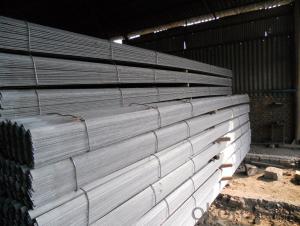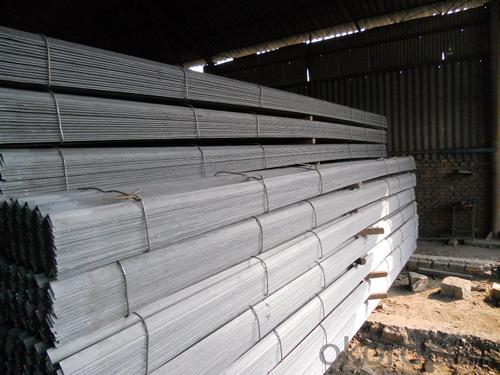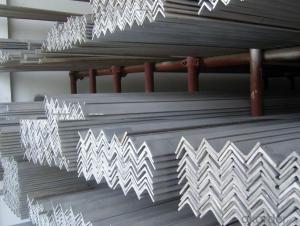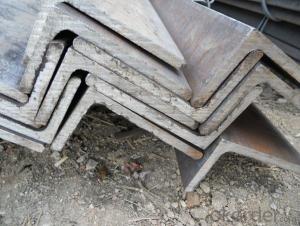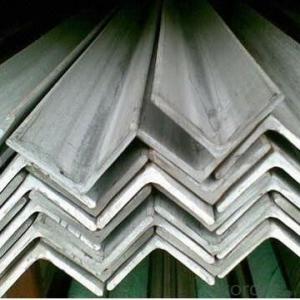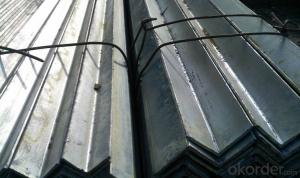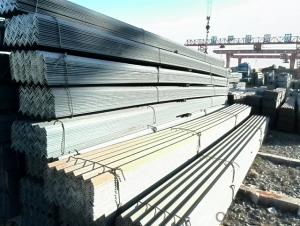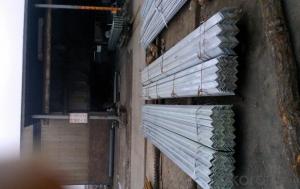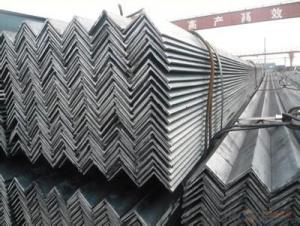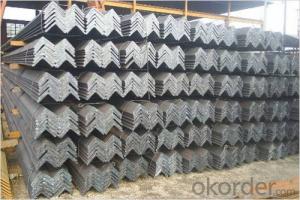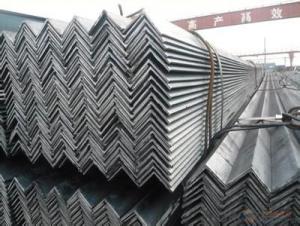Hot Rolled Steel Angle Q235, A36,SS400 for Strcuture
- Loading Port:
- Tianjin
- Payment Terms:
- TT or LC
- Min Order Qty:
- 25 m.t.
- Supply Capability:
- 200000 m.t./month
OKorder Service Pledge
OKorder Financial Service
You Might Also Like
Product Description:
Specifications of Hot Rolled Steel Angle Q235, A36,SS400 for Strcuture
1. Invoicing on theoretical weight or actual weight as customer request
2. Length: 6m, 9m, 12m as following table
3. Sizes
Sizes: 25mm-250mm | ||
a*t | ||
25*2.5-4.0 | 70*6.0-9.0 | 130*9.0-15 |
30*2.5-6.6 | 75*6.0-9.0 | 140*10-14 |
36*3.0-5.0 | 80*5.0-10 | 150*10-20 |
38*2.3-6.0 | 90*7.0-10 | 160*10-16 |
40*3.0-5.0 | 100*6.0-12 | 175*12-15 |
45*4.0-6.0 | 110*8.0-10 | 180*12-18 |
50*4.0-6.0 | 120*6.0-15 | 200*14-25 |
60*4.0-8.0 | 125*8.0-14 | 250*25 |
5. Payment terms:
1).100% irrevocable L/C at sight.
2).30% T/T prepaid and the balance against the copy of B/L.
3).30% T/T prepaid and the balance against L/C
6.Material details:
Alloy No | Grade | Element (%) | |||||
C | Mn | S | P | Si | |||
Q235 | B | 0.12—0.20 | 0.3—0.7 | ≤0.045 | ≤0.045 | ≤0.3 | |
Alloy No | Grade | Yielding strength point( Mpa) | |||||
Thickness (mm) | |||||||
≤16 | >16--40 | >40--60 | >60--100 | ||||
≥ | |||||||
Q235 | B | 235 | 225 | 215 | 205 | ||
Alloy No | Grade | Tensile strength (Mpa) | Elongation after fracture (%) | ||||
Thickness (mm) | |||||||
≤16 | >16--40 | >40--60 | >60--100 | ||||
≥ | |||||||
Q235 | B | 375--500 | 26 | 25 | 24 | 23 | |
Usage & Applications of Hot Rolled Steel Angle Q235, A36,SS400 for Strcuture
According to the needs of different structures, Angle can compose to different force support component, and also can be the connections between components. It is widely used in various building structures and engineering structures such as roof beams, bridges, transmission towers, hoisting machinery and transport machinery, ships, industrial furnaces, reaction tower, container frame and warehouse etc.
Packaging & Delivery of Hot Rolled Steel Angle Q235, A36,SS400 for Strcuture
1. Packing: it is nude packed in bundles by steel wire rod
2. Bundle weight: not more than 3.5MT for bulk vessel; less than 3 MT for container load
3. Marks:
Color marking: There will be color marking on both end of the bundle for the cargo delivered by bulk vessel. That makes it easily to distinguish at the destination port.
Tag mark: there will be tag mark tied up on the bundles. The information usually including supplier logo and name, product name, made in China, shipping marks and other information request by the customer.
If loading by container the marking is not needed, but we will prepare it as customer request.
Production flow of Hot Rolled Steel Angle Q235, A36,SS400 for Strcuture
Material prepare (billet) —heat up—rough rolling—precision rolling—cooling—packing—storage and transportation
Images of Hot Rolled Steel Angle Q235, A36,SS400 for Strcuture
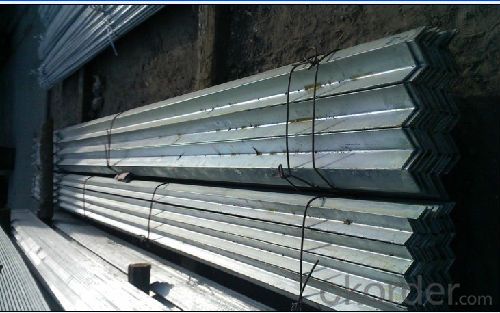
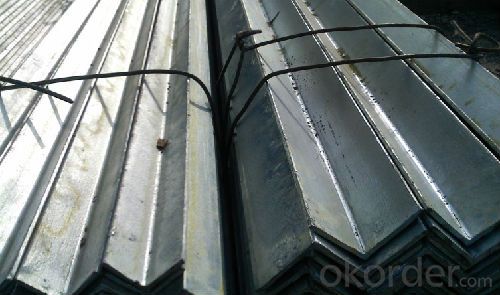
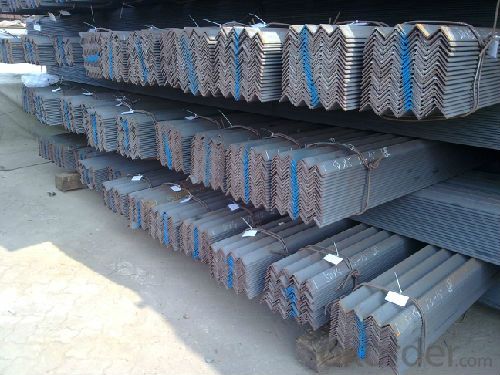
- Q: Can steel angles be used for supports in bridges?
- Steel angles can indeed be utilized as supports in bridges. These angles are frequently employed in bridge construction due to their capacity to provide both strength and stability. They serve as vertical supports, known as piers or columns, as well as horizontal supports, referred to as beams or girders. The usage of steel angles in bridge construction offers numerous benefits. These include their exceptional strength-to-weight ratio and their ability to endure substantial loads and vibrations. Moreover, steel angles are highly adaptable and can be easily fabricated and connected, resulting in efficient and cost-effective bridge construction. All in all, due to their enduring nature, dependability, and efficiency in supporting the weight and load of a bridge structure, steel angles are widely favored as a choice for bridge supports.
- Q: How do steel angles contribute to the overall stability of a structure?
- Steel angles contribute to the overall stability of a structure by providing additional strength and support. They are often used as structural members in construction projects to connect and reinforce different components, such as beams and columns. The angles help distribute and transfer loads, improving the structure's resistance to bending, buckling, and other forces. Additionally, their L-shape design allows them to resist shear and torsional stresses, enhancing the overall stability and integrity of the structure.
- Q: Are steel angles cost-effective?
- Yes, steel angles are cost-effective. Steel angles are widely used in various industries and construction projects due to their versatility and durability. They are highly cost-effective because they are easy to manufacture, readily available, and have excellent strength-to-weight ratios. Steel angles also have a long lifespan, reducing the need for frequent replacements or repairs, which can save on maintenance costs in the long run. Additionally, steel angles are recyclable, making them an environmentally friendly and sustainable choice. Overall, the cost-effectiveness of steel angles makes them a popular choice for structural and architectural applications.
- Q: Can steel angles be used as supports for HVAC systems or ductwork?
- Yes, steel angles can be used as supports for HVAC systems or ductwork. Steel angles provide excellent strength and durability, making them ideal for supporting the weight of HVAC systems and ductwork. They can easily be mounted to walls or ceilings to provide a stable and secure support structure.
- Q: Can steel angles be used in HVAC ductwork installations?
- Indeed, steel angles have the capability to be utilized in HVAC ductwork installations. In the realm of ductwork systems, steel angles are frequently employed to furnish the necessary support and stability. Their typical function involves acting as brackets or supports, securing the ducts firmly in position and preventing undesirable sagging or collapsing caused by the weight of the air conditioning or heating equipment. Given their robustness and durability, steel angles are well suited to withstand the forces and vibrations inherent in HVAC systems. Moreover, the ease with which steel angles can be welded or bolted together allows for a secure and stable installation. To summarize, steel angles are an exceedingly reliable and widely utilized element in HVAC ductwork installations.
- Q: Are steel angles suitable for architectural cladding?
- Yes, steel angles can be suitable for architectural cladding. Steel angles offer structural support and can be used to create clean lines and sharp corners in architectural designs. They are durable, weather-resistant, and can be customized to match the desired aesthetic. Additionally, steel angles provide versatility in terms of installation and can be easily attached to different building materials.
- Q: Can steel angles be used for framing windows?
- Indeed, framing windows with steel angles is a viable option. Widely employed in construction, steel angles offer supplementary structural support and stability as window frames. Their durability, strength, and ability to resist warping or bending make them well-suited for this task. Moreover, steel angles can be effortlessly tailored and modified to match the precise measurements and specifications of the window frame, ensuring a secure and accurate installation.
- Q: Can steel angles be used in conveyor belt supports?
- Yes, steel angles can be used in conveyor belt supports. Steel angles are commonly used as structural supports in various applications due to their strength and durability. They provide excellent load-bearing capacity and can withstand heavy weights, making them suitable for supporting conveyor belts. The angles can be used to create a sturdy framework or structure that holds the conveyor belt in place and allows it to move smoothly. Additionally, steel angles can be easily fastened or welded together, providing a secure and stable support system for conveyor belts.
- Q: Can steel angles be used for temporary or removable structures?
- Yes, steel angles can be used for temporary or removable structures. Steel angles provide structural support and stability, making them suitable for various applications such as scaffolding, temporary frames, or modular structures that can be easily assembled and disassembled.
- Q: How do steel angles contribute to architectural design?
- Steel angles are an essential component in architectural design as they offer structural stability and design flexibility. These angled steel profiles are commonly used to provide support and reinforcement in various construction projects, including buildings, bridges, and other structures. One of the key contributions of steel angles to architectural design is their ability to improve the structural integrity of a building. As these angles are often used to create rigid connections between different structural elements, they add strength and stability to the overall structure, ensuring it can withstand various loads and forces. This is particularly crucial in high-rise buildings or structures located in areas prone to earthquakes or strong winds. Moreover, steel angles enable architects and designers to create unique and innovative architectural features. Their versatility allows for the creation of aesthetically pleasing designs, such as cantilevered balconies, intricate facades, and distinctive rooflines. Steel angles can be easily manipulated and welded, making them suitable for complex geometric shapes and creative design concepts. Additionally, steel angles offer cost-effective solutions in architectural design. They are readily available in various sizes and lengths, making them easy to source and integrate into construction projects. Their durability and low-maintenance properties make them a long-lasting and economical choice for architects, reducing the need for frequent repairs or replacements. Furthermore, steel angles contribute to sustainability in architectural design. Steel is a highly recyclable material, and using steel angles in construction projects reduces the demand for new materials. Additionally, the lightweight nature of steel angles allows for efficient transportation, reducing carbon emissions during the construction process. In conclusion, steel angles play a vital role in architectural design by providing structural support, design flexibility, cost-effectiveness, and sustainability. Their use enhances the overall strength and stability of a structure while enabling architects to create visually appealing and unique designs. With their numerous benefits, steel angles have become an indispensable element in modern architectural design.
Send your message to us
Hot Rolled Steel Angle Q235, A36,SS400 for Strcuture
- Loading Port:
- Tianjin
- Payment Terms:
- TT or LC
- Min Order Qty:
- 25 m.t.
- Supply Capability:
- 200000 m.t./month
OKorder Service Pledge
OKorder Financial Service
Similar products
Hot products
Hot Searches
Related keywords
